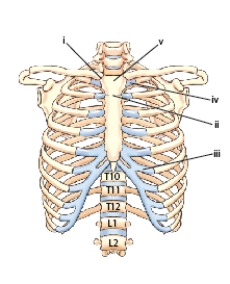A) They do not possess a head.
B) They do not possess a costovertebral joint.
C) They do not possess costocartilage.
D) They are ribs 10 through 12.
Correct Answer

verified
Correct Answer
verified
Multiple Choice
What is the primary term for the superior margin of the sternum?
A) Sternal notch
B) Manubrial notch
C) Suprasternal notch
D) Jugular notch
Correct Answer

verified
Correct Answer
verified
Multiple Choice
The structure labeled iii is costocartilage:

A) of the 10th rib.
B) portion of the first false rib.
C) of the last true rib.
D) of the sixth rib.
Correct Answer

verified
Correct Answer
verified
Multiple Choice
A radiograph of an RAO sternum reveals that it is partially superimposed over the spine.What must be done to eliminate this problem during the repeat exposure?
A) Perform an LPO projection instead of an RAO.
B) Angle CR 5° to 10° laterally to the sternum.
C) Increase rotation of the body.
D) Increase kV.
Correct Answer

verified
Correct Answer
verified
True/False
A recommended practice is to decrease the SID to less than 40 inches (102 cm)for the oblique sternum projection to increase the magnification and resultant unsharpness of overlying ribs.
Correct Answer

verified
Correct Answer
verified
Multiple Choice
At approximately what age does the xiphoid process become totally ossified?
A) 12 years old
B) 21 years old
C) 40 years old
D) The xiphoid process never becomes ossified.
Correct Answer

verified
Correct Answer
verified
Multiple Choice
A radiograph of an RAO projection of the ribs demonstrates the left axillary ribs are foreshortened,whereas the right side is elongated.Which of the following is the most likely reason for this radiographic outcome?
A) The patient requires more rotation to the right.
B) An LAO was performed rather than the RAO position.
C) The technologist should have performed a PA projection to demonstrate the left axillary ribs, not an RAO.
D) CR angulation was incorrect.
Correct Answer

verified
Correct Answer
verified
True/False
The degree of rotation for the right anterior oblique (RAO)projection of the sternum is dependent on the size of the thoracic cavity.
Correct Answer

verified
Correct Answer
verified
Multiple Choice
The widest aspect of the thorax generally occurs at the level of:
A) the eleventh and twelfth ribs.
B) T7.
C) the sternoclavicular joints.
D) the eighth or ninth ribs.
Correct Answer

verified
Correct Answer
verified
Multiple Choice
A patient enters the ED with an injury to the left anterior lower ribs.Which of the following projections should be taken to demonstrate the involved area?
A) AP and LAO
B) PA and RAO
C) AP and LPO
D) PA and LAO
Correct Answer

verified
Correct Answer
verified
Multiple Choice
What is the joint classification and type of movement for the sternoclavicular joints?
A) Cartilaginous with diarthrodial (ginglymus) movement
B) Synovial with diarthrodial (gliding) movement
C) Synovial with amphiarthrodial, limited movement
D) Cartilaginous with synarthrodial or no movement
Correct Answer

verified
Correct Answer
verified
Multiple Choice
Fracture of adjacent ribs in two or more places with associated pulmonary injury is known as a(n) _____ rib fracture.
A) compound
B) flail chest
C) acute
D) compression
Correct Answer

verified
B
Correct Answer
verified
Multiple Choice
Which analog kV range is recommended for an AP study of the ribs found below the diaphragm?
A) 85 to 90 kV
B) 60 to 65 kV
C) 65 to 75 kV
D) 70 to 80 kV
Correct Answer

verified
Correct Answer
verified
Multiple Choice
Which of the following ribs is considered to be a false rib?
A) Seventh
B) First
C) Ninth
D) None of the above
Correct Answer

verified
Correct Answer
verified
Multiple Choice
Which disease or condition may be associated with postoperative complications of open heart surgery?
A) Spondylitis
B) Osteoblastic metastases
C) Osteomyelitis
D) Flail chest
Correct Answer

verified
Correct Answer
verified
True/False
A lateral projection of the sternum requires that respiration be suspended on expiration.
Correct Answer

verified
Correct Answer
verified
Multiple Choice
Initial PA projections of the SC joints indicate a possible defect involving the left SC joint.The vertebral column is preventing a clear view of it.Which of the following projections will demonstrate the right SC joint without superimposition over the spine?
A) Horizontal beam lateral
B) LAO
C) RAO
D) Erect lateral projection
Correct Answer

verified
C
Correct Answer
verified
Multiple Choice
Why is the RAO sternum preferred to the LAO position?
A) The RAO produces less magnification of the sternum.
B) The RAO projects the sternum over the shadow of the heart.
C) The RAO reduces dose to the thyroid gland.
D) The RAO projects the sternum away from the hilum and heart.
Correct Answer

verified
Correct Answer
verified
Multiple Choice
What is the recommended SID for the lateral sternum position?
A) 40 inches (102 cm)
B) 44 inches (113 cm)
C) 46 inches (117 cm)
D) 60 to 72 inches (152 to 183 cm)
Correct Answer

verified
Correct Answer
verified
Multiple Choice
A radiograph of an RAO projection of the sternum demonstrates excessive lung markings obscuring the sternum.A 1-second exposure time and an orthostatic (breathing) technique were used.Which of the following will produce a more diagnostic image of the sternum?
A) Ensure that the patient is not breathing during the exposure.
B) Increase the exposure time; decrease the mA.
C) Decrease the kV; increase the mA or time.
D) Initiate exposure on deeper inspiration.
Correct Answer

verified
B
Correct Answer
verified
Showing 1 - 20 of 66
Related Exams